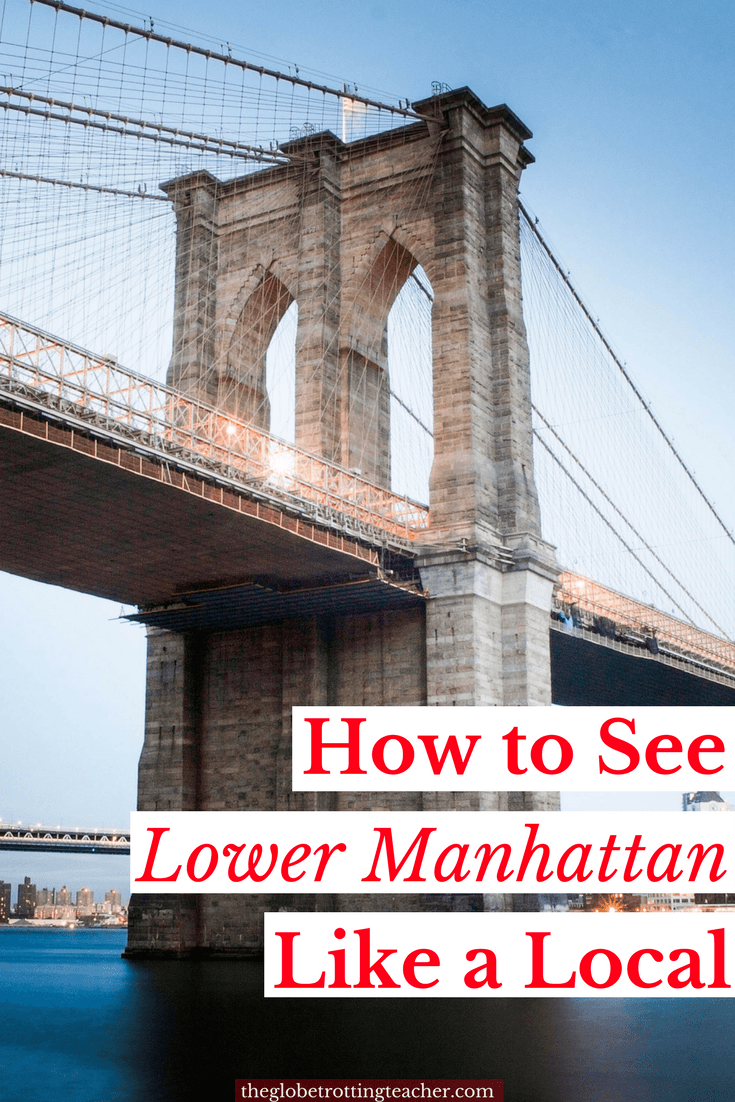In the city that never sleeps, it’s easy to be captivated and even overwhelmed by NYC’s endless opportunities to explore, sightsee, get lost, and be entertained.
Truthfully, most New York City visitors only scratch the surface by visiting popular spots like Times Square, the Empire State Building, and Central Park. But, this leaves out all of the many amazing things to do in Lower Manhattan!
As a local New Yorker, I’d like to highlight a Lower Manhattan itinerary that includes some well-known spots, as well as some under-the-radar gems, you may not realize are right under your nose.
This guide lists out the many things to do in Lower Manhattan in the hope you can really get to know Lower Manhattan.
Let’s head south, shall we?

How to Explore Lower Manhattan like a Local
I hear from many first-time NYC visitors trying to plan out a New York itinerary who feel confused about what to do in Lower Manhattan, especially.
There are so many Lower Manhattan neighborhoods and it’s hard to know what to see and how to map it all out.
The sections below are broken up by days, assuming you’re trying to make the most of 2 days in Lower Manhattan. However, keep in mind, the area can keep you busy for many more days!
I’ve highlighted some Lower Manhattan musts and then leave the rest up to you to decide how to plan your time.
Day 1 – Financial District, Battery Park, and the Brooklyn Bridge
Let’s start at the 9/11 Memorial and Museum, one of the many things to do in NYC’s financial district. Luckily, several subway trains stop nearby.
Assuming you’re staying further uptown in Midtown near Times Square, take the subway in the downtown direction to Lower Manhattan.
The 1, R, and W trains stop at Cortlandt Street. The 2 and 3 trains stop at Park Place. And, the 4 and 5 trains make a stop at Fulton Street. All of these stops are for the World Trade Center area.
Once out of the subway, head toward the 9/11 Memorial and Museum, which opened to the public in the spring of 2014.
You’ll immediately notice the Memorial area with the North and South Reflecting Pools which are the original footprints of the Twin Towers. Names of the victims are inscribed into the surrounding ledges. The Freedom Tower is in view and there are trees and other plantings designed to make the area a solemn but welcoming place.
The 9/11 Museum entrance is located between the 2 reflecting pools and is important to see while you visit Lower Manhattan. The museum is incredibly well-done, serving both as a tribute to those lives lost and as an educational center about the events of that day.
There are firsthand accounts and countless artifacts teaching about the events of that infamous day.
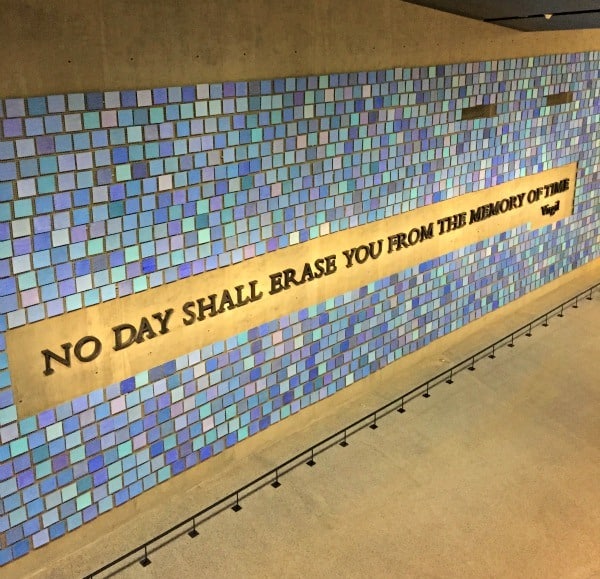
As you’d probably expect, it’s an emotional visit. Because of this, the museum does have early exits if you wish to leave specific rooms or areas.
Avoid waiting in line to enter the museum by purchasing a timed-entry ticket online before your visit. Depending on what other New York City sights you plan to visit, it might make sense to purchase a New York CityPASS. It’s a bundled ticket sold at a discount with entry to 6 NYC sights including the 9/11 Museum.
Keep in mind, the 9/11 Museum suggests the subject matter may not be suitable for children under 10 years old. And, depending on your pace, the museum visit could take between 2-3 hours.
I started by saying Lower Manhattan has a lot to see and do! You can easily spend a few days right here in these few blocks around the World Trade Center. Choose from these ideas as you plan your time.
One World Observatory, otherwise known as the Freedom Tower, is the tallest skyscraper in New York City and the Western Hemisphere. You can ride the elevators up 102 floors for sweeping birds-eye views over New York City and the Hudson River.
If you go, get a skip-the-line ticket in advance. This will also give you a timed entry so you know exactly when to visit.
The Oculus is the World Trade Center transportation hub. You can’t miss its white, bird-like shape just across from the 9/11 Memorial and Museum. Inside, you’ll find shops and connections to several subway lines.
Whether you want to shop or not, it’s worth it to take a quick peek inside. There’s a great photo-op from the top of the stairs overlooking the space.
ProTip: Public bathrooms are hard to find in NYC, but the Oculus has them if you need it.
Continuing with the itinerary from the World Trade Center, walk a block up to Church Street and then south a couple of blocks to historic Trinity Church.
On 9/11, many people ran inside this church to get away from falling debris. But, Trinity Church has a notable history in Lower Manhattan. The current church is the 3rd one to stand on this site. The others were destroyed by fire or damaged by severe weather.
Throughout the Parish history, it’s been occupied by the British during the American Revolution. Later, it was where George Washington and early members of the government attended church.
Today, though, visitors are drawn to the adjoining colonial cemetery to see the graves of Alexander Hamilton, his wife, son, and sister-in-law. However, take a moment to walk around because there are delegates of the Continental Congress and signers of the Declaration of Independence all buried here.
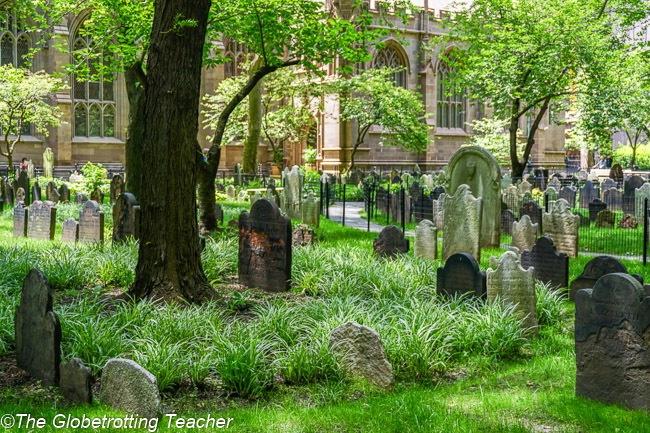
For fans of the Broadway musical Hamilton, see if you can find the gravestone for Hercules Mulligan, the American Revolutionary spy who gathered key intelligence for George Washington and the Revolutionary Army.
From Trinity Church, you’re just across from Wall Street. Follow it to see the outside of the New York Stock Exchange and the Fearless Girl Statue.
You’ll also see Federal Hall with its larger-than-life statue of George Washington. New York City was the nation’s first Capital and Federal Hall was where our first President was inaugurated.
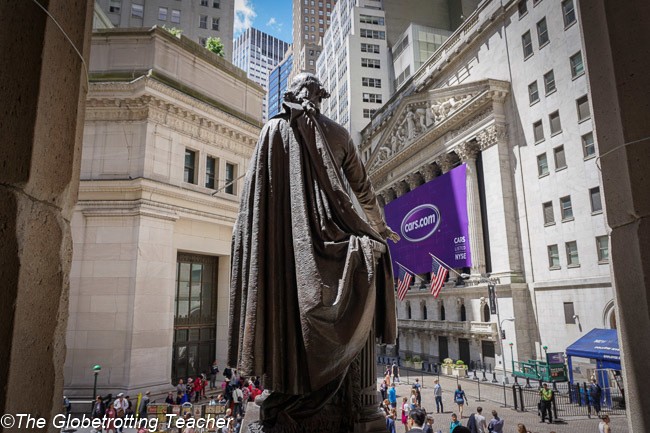
Today, Federal Hall is managed by the National Park Service and is open Monday-Friday from 9 a.m.- 5 p.m. It’s free to go inside and a place to learn more about the Revolutionary War and George Washington’s inauguration. Sometimes, old George makes an appearance in uniform, too!
ProTip: On Wall Street just in front of Federal Hall, look down for square markers in the road. This is where the original posts were for the actual wall that early settlers built to protect their colony at the southern tip of Manhattan.
Again, there are a lot of things to do in Downtown Manhattan. You could choose to stay right here for the day and enjoy the many Battery Park attractions in the area. Here are a few ideas.
The Charging Bull Statue sits at the top of Bowling Green. Originally, outside the Stock Exchange on Wall Street, the bull stands strength and going after your own financial prosperity.
Bowling Green may look just like a small green space but it’s chock full of history! The earliest settlers and Native Americans held markets here. During colonial times, a statue of King George III stood in the square. When news that the Declaration of Independence had been signed reached New York City, revolutionaries tore down the statue and melted it down for Revolutionary War ammunition.
ProTip: Look at the fence around Bowling Green. You see uneven hack marks on the tops of some of the fence posts. There were crowns on top of those posts and they were sawed off when the King’s statue was torn down.
The National Museum of the American Indian is unmissable in front of Bowling Green. It houses thousands of artifacts showing Native people in North America and how they lived. The museum building was the original home of the Alexander Hamilton U.S. Custom House and the site where the original Fort Amsterdam stood back when the Dutch colony of New Amsterdam (York came later…) was growing.
Castle Clinton, a rounded fort in Battery Park, was built in the early 1800s to defend against British attacks. It became an immigration arrival center before there was one on Ellis Island. Today, the National Parks Service has restored the site to its original appearance.
This is where boats leave for Statue of Liberty and Ellis Island trips here. There’s also a historical exhibition about the fort and the history of New York City.
ProTip: If you’re ok with simply seeing the Statue of Liberty from a slight distance, go to the southern tip of Manhattan and catch the Staten Island Ferry for FREE. It’s one of the most popular things to do near Battery Park. You’ll pass by Lady Liberty and get a spectacular from-the-water view of Lower Manhattan. When you arrive on Staten Island, simply take the ferry back.
Historic Fraunces Tavern and Museum on Pearl Street serves lunch, dinner, as well as brunch on weekends. The history of this place goes back 300 years. Notably, after the Revolutionary War, George Washington held a dinner on the 2nd floor to celebrate victory and thank his army officers. The museum upstairs retells and recreates some of this history.
Nearby Stone Street is also historic in its own right. (It was the first paved street of the young colony all thanks to a Doctor’s wife who continually protested the dust from the road constantly flying up onto her porch!) Today, restaurants with outdoor seating line the street and can be a fun place to rest tired feet and refuel.
ProTip: Lower Manhattan is the oldest part of the city and the street names are clues to what may have gone on there in the past. Wall Street had a wall. Pearl Street was the site of a huge oyster shell heap, which was later used to pave the road.
If you’re sticking to a schedule because you’ve got limited time in Lower Manhattan, walk along Wall Street from Federal Hall towards the East River and go north (a left) on Front St.
You’ll come to South Street Seaport with the Brooklyn Bridge just beyond. The seaport is a historic, cobblestoned area now full of shops and restaurants. There are ships to tour, as well.
Depending on how much time you have, take some time to explore, but the priority here is the Brooklyn Bridge.
Of all the things to see in Lower Manhattan, the Brooklyn Bridge still takes my breath away. It’s my all-time favorite NYC landmark.
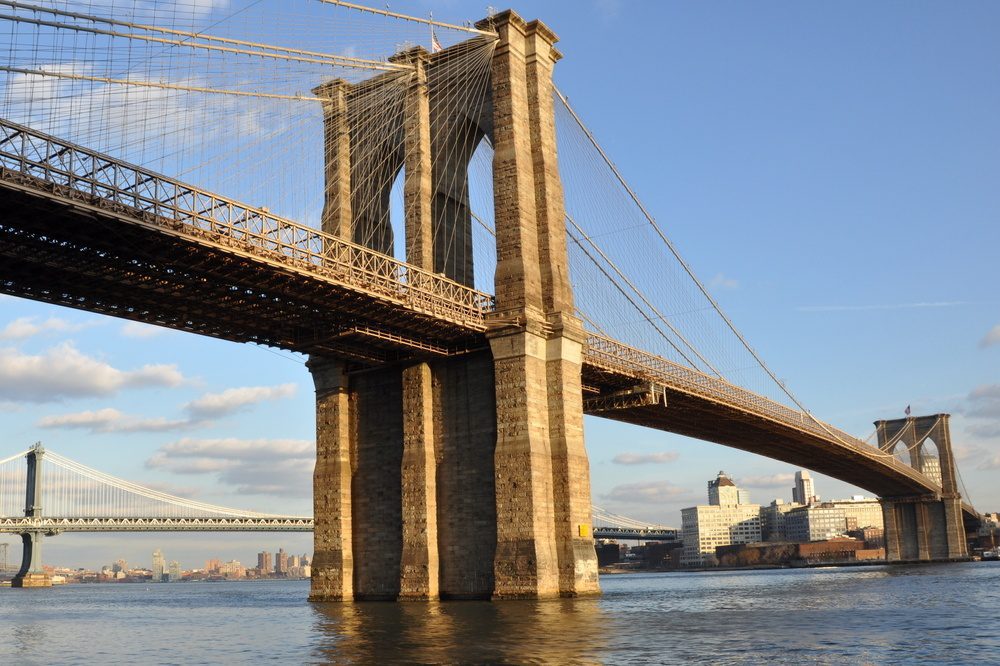
No visit to Lower Manhattan, or to NYC for that matter, is complete without walking on the Brooklyn Bridge’s elevated pedestrian promenade to admire the East River, the city skyline, and, of course, the bridge itself.
The history of how the Brooklyn Bridge was built is an incredible story and I could elaborate at length on the bridge’s engineering and the dramatic plot twists that took place during its construction. But I get it. You’re planning your trip, not in my Social Studies class. 😉
The entrance to the Pedestrian Promenade is just across from the side of City Hall. As you walk onto the bridge, just take a moment to think about the epic task it was to build such a bridge…before electricity and power tools.
Yes, the Brooklyn Bridge was built totally by hand.
The stone towers with their pointed Gothic arches and the geometric designs of the cables make for great photo opportunities, so snap away, just beware of the cyclists!
You’ll undoubtedly be hungry after walking on the Brooklyn Bridge and visiting the 9/11 Museum, so let’s go to Chinatown!
Turn right off the Brooklyn Bridge once you’re back to the street level. You want to walk along Centre Street before turning right on Worth Street. Once you get to Mulberry Street or the next street, Mott, you’re in Chinatown and what is left of Little Italy.
ProTip: If you’re too tired to walk, head back towards Broadway and City Hall Park to catch either the “R” or “6” Train uptown to Canal Street, a.k.a Chinatown.
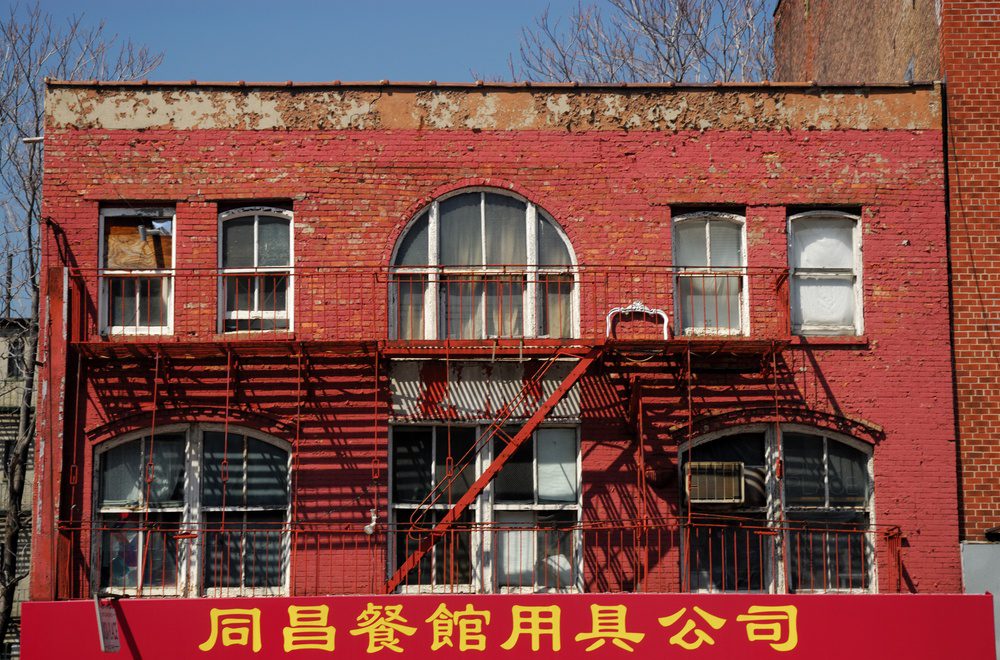
Wander through the neighborhood’s little streets. Use Mott Street to find off-the-beaten-path streets, Pell and Doyers. Film and TV crews have used these quiet streets for numerous scenes in TV shows and movies.
The famous Nom Wah Tea Parlor is on Doyers and is still serving food after nearly 90 years. Tings Gift Shop is another classic, selling trinkets you can only find in Chinatown.
Don’t be fooled by the calm, though. Doyers Street used to be infamous in the 1930s for its Chinese gang murders and its secret alleys to help gang members escape.
When you’re blissfully stuffed from authentic Chinese food and have purchased some souvenirs and maybe even some exotic Asian fruit, pat yourself on the back for a day well-spent exploring Lower Manhattan.
ProTip: There are many NYC Dos and Don’ts. Little Italy is a don’t. Controversial, I know. But, opt instead for some authentic Italian bites in the next part of my Lower Manhattan itinerary. Keep reading!
Day 2 – The High Line, Greenwich Village, and the Lower East Side
No exploration of Lower Manhattan is complete without a visit to Greenwich Village and the Lower East Side.
Starting again in Midtown because it’s the most popular area to stay, go the entrance of the High Line at W. 34th Street in between 11th and 12th Avenues.
You can do the 20-minute walk from the Times Square area or take the 7 train from Times Square to the last stop, Hudson Yards. From there, it’s just a couple of minutes to the High Line entrance.
The High Line is an elevated, urban park built on old freight railway tracks. It runs from 34th Street to its southernmost point at Gansevoort and Washington Streets all along Manhattan’s far west side.
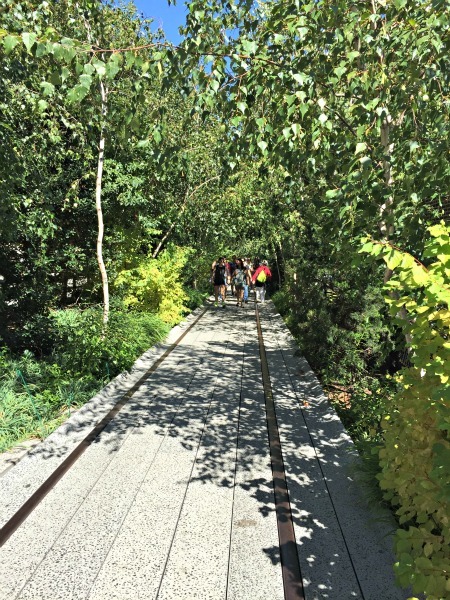
There are plantings and gardens along the old rail tracks, as well as art installations, exhibitions, events, and food and drink carts along the way. Save your appetite, though! Good eats are not far away.
Anytime is great for strolling but New York in the fall brings pleasant blue-sky days perfect for enjoying urban green spaces.
Be sure to take in the views and the city life below you. The iconic NYC skyline will be to your left with plenty of chances to spot the Empire State Building.
The walk is about a mile and a half but it feels quicker than that because there are no streets to cross. The time it takes all depends on how many stops you make along the way.
Depending on your interests, there are a couple of spots you might consider as you exit the High Line.
The High Line finishes at the Whitney Museum of American Art, which highlights work by American artists of today. Exhibitions change so it’s best to see what’s on display at the time of your visit.
Chelsea Market is also just off this southern end of the High Line. You can exit before the last exit at 16th Street if you’d like to visit. The shops are trendy. The food stalls and eateries cater to small bites and counter seating. Beware, though, of touristy prices.
Having exited the High Line, go left on Gansevoort Street (away from the river) and then turn right onto Hudson Street. From there, you’ll want to bear to the left onto Bleecker Street because we are heading into the cozy, yet glamorous Greenwich Village.
Sex and the City fans will want to turn left onto Perry Street. Carrie Bradshaw’s brownstone is number 66.
Either way, continue back on Bleecker Street before turning right onto Grove Street. Notice the narrow streets and how they’re lined with houses and quieter than busy midtown. Among these streets are countless not-to-miss places! Here are a few.
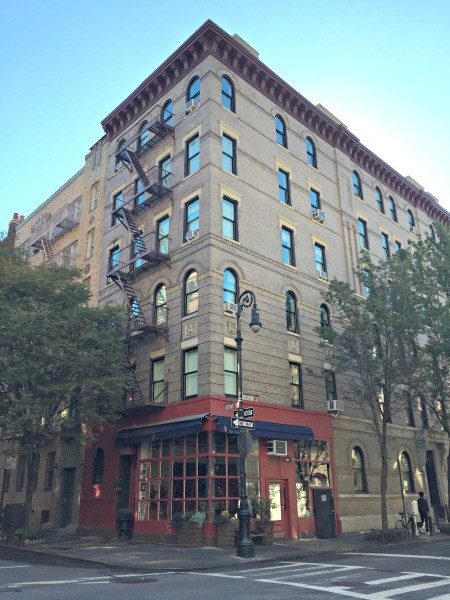
One block away at the corner of Grove and Bedford Streets, you’ll find the apartment building used for exterior shots of the popular sitcom, Friends.
Before turning left down Bedford Street, take a look at one of the oldest houses in NYC, made with a wooden frame, which today is not permitted by modern-day building codes. It was built in 1822.
Next, look for 75.5 Bedford Street, a.k.a the narrowest house in NYC, at just 9 feet wide! It was once the home to several celebrities, including Cary Grant.
Turn right for 1 block on Commerce Street and bear to the left onto 7th Avenue. Cross 7th Avenue because the next stop is a delicious section of Bleecker Street.
I hope you’re feeling hungry!
Bleecker Street is its own Little Italy! You could do your own foodie tour on Bleecker Street alone. And if you ask me, the pizza in Lower Manhattan is among the city’s best!
Stop at Bleecker Street Pizza for a margarita slice named the “best pizza in New York City” by the Food Network.
As you continue down Bleecker Street, there are several notable Lower Manhattan restaurants here including Murray’s Cheese Bar and Keste. I prefer to walk and sample bites instead of sitting down.

Taste the rice balls at Faiccos’s Italian Specialties.
Don’t miss the cannolis and other sweets at Pasticceria Rocco.
Then, pass the old Italian church on the corner of Bleecker Street and turn left onto Carmine Street. Stop at Joe’s Pizza for a classic New York City cheese slice. You’ll see the difference from the last slice.
Then, cross 6th Avenue to Minetta Lane, on your way to Macdougal Street.
At 111 Macdougal Street, taste an artichoke slice at the aptly named Artichoke Pizza. You simply cannot leave Greenwich Village without tasting it!
The artichokes are chopped up super fine or pureed and mixed with a creamy, cheesy concoction of pizza heaven. The crust is doubled for extra crunchiness.
Now that you’re utterly stuffed, walk along Macdougal in the opposite direction of Artichoke Pizza.
While you’re here, take stock of how historic Macdougal Street is!
Cafe Wha is where Bob Dylan played in his early days.
Mamoun’s Falafel was featured in the “1,000 Things to Do Before You Die” book. Go ahead and taste some falafel if you have space.
Cafe Reggio was used for several Godfather II scenes.
And across the street in one of the houses, Louisa May Alcott wrote part of her classic novel, Little Women.
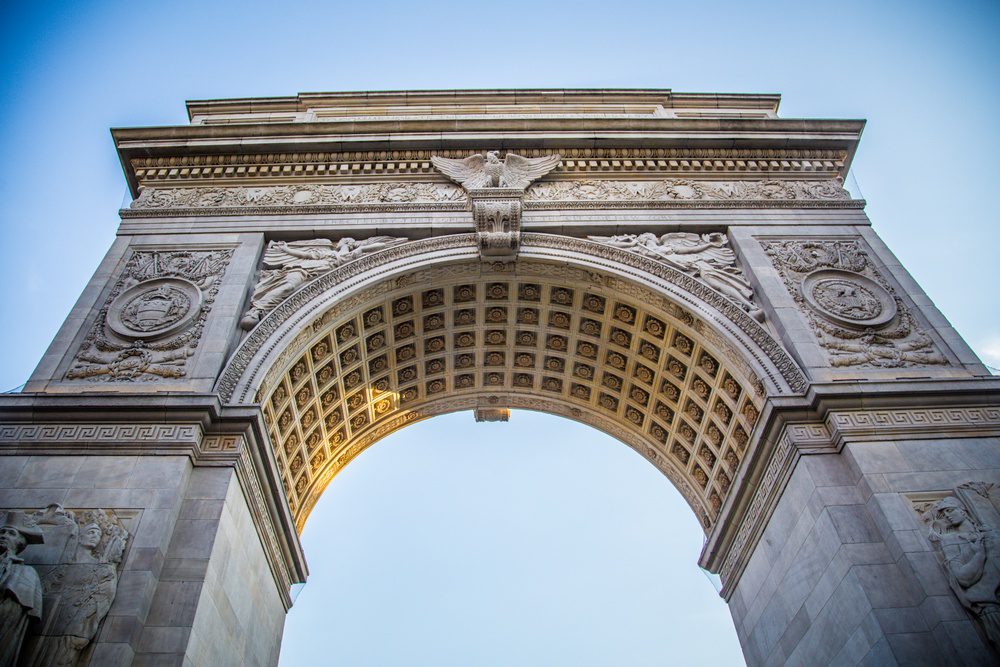
In less than 2 blocks, you’ll come to Washington Square Park. The park is one of the most well-known in New York City and its signature arch is a popular spot for photos.
The history of this park is a blog post until itself. The land was once a Native and African settlement, as well as a (former) public burial ground. Today, the park is great for a stroll and some classic New York City people-watching.
When you’ve had your fill of the park, go back to 6th Avenue and West 4th Street to the subway station. Take the F train to the Delancey Street and Essex Street station. To orient yourself, the F train will be going in the direction of Coney Island and Stillwell Avenue.
This will leave you in between the East Village and NYC’s Lower East Side.
From Greenwich Village and its homey, tree-lined blocks, this area has a more bohemian, less polished feel. It’s also home to one of the most fascinating museums in Lower Manhattan, the Tenement Museum.

From the 1860s to the 1930s, mass waves of immigrants sailed into New York Harbor in search of a better life. Many of them ended up living in cramped tenement houses on the Lower East Side of Manhattan. This museum is housed in one of those tenement buildings with artifacts and exhibitions on display from people who lived there.
If you’re someone who had ancestors immigrate to the United States like I did during this time, the Tenement Museum shows what life was like and what these newcomers needed to do in order to make a new life.
The museum offers a variety of guided tours (lasting around an hour) through the museum and neighborhood ranging from the Irish Outsiders tour to more about life as a sweatshop worker.
Even if you wouldn’t consider yourself a history buff, the Tenement Museum often ends up being many people’s surprise highlight of what to do in Lower Manhattan.
ProTip: For a contrast of how the upper class was living just 15 minutes away (on foot), visit the little-known gem, the Merchant House Museum.

When you’re done at the museum, walk back towards the subway at Delancey and Essex but turn left onto Ludlow Street first.
Walk up 3 blocks to Katz’s Deli for a legendary New York City sandwich, whether you go with pastrami or corned beef.
ProTip: If you’re not interested in a deli sandwich, the Lower East Side has a great restaurant scene. Take advantage while you’re in the neighborhood!
When you’re done, you can use the F train to return to midtown. It stops at 34th St- Herald Square, 42nd St- Bryant Park, and at Rockefeller Center.
Have I covered all of what to see in Lower Manhattan?
Of course not! That would be nearly impossible in the city that never sleeps.
Hopefully, though, this Lower Manhattan itinerary helps you explore like a local and get the most from your time in Downtown Manhattan.
Which things would you like to do in Lower Manhattan?
Like this post? Please share it on social media using the share buttons below.
